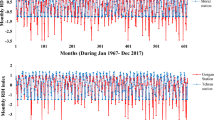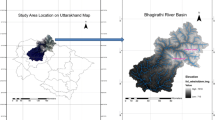Abstract
Considering the importance of climate change and its effects, especially in recent decades, the forecast of future climate conditions can be useful in managing and planning to reduce its impacts. The hypothesis of this study is that in periodic data series, such as seasonal (3-month) and monthly data, the periodically correlated time series models (PC) have a more ability to predict data series. Therefore, in this research using climatic data series of 18 synoptic stations during 1967–2017 over Iran (with different climate conditions and suitable spatial distribution), initially, the climate conditions based on united nation environmental program (UNEP) aridity index (UAI) in seasonal time scale were assessed, and then, using PC models including Periodic Autoregressive Moving Average (PARMA), Periodic Moving Average (PMA) and Periodic Autoregressive (PAR) the UAI from 2018 to 2030 were predicted and finally, for increasing the applicability of the results of the research the trend of changes in UAI data series on observed data (during 1967–2017) and observed and forecasted data (during 1967–2030) were assessed and compared. The results showed calculated UAI at all stations were periodical (significantly at 0.05% level) and among different PC time series models such as PARMA, PMA and PAR, the PAR model with order 22 [PAR (22)] was the best time series model that fitted in all data series at all stations. The R-squared between the observed and the simulated [based on PAR (22) model] UAI from 1967 to 2017 at all stations were more than 0.610 (significantly at 0.01% level) and the R-squared between the observed and the predicted [based on PAR (22) model] UAI from 2013 to 2017 for validating fitted models at all stations were more than 0.659 (significantly at 0.01% level). Trend assessment of climate conditions showed the climate conditions will be dryer at 94.44% (17 out of 18) of stations (only at Gorgan, the climate conditions will be more humid).










Similar content being viewed by others
References
Ahmadi H (2008) Applied geomorphology desert-wind erosion. Tehran University Press, Tehran
Aili T, Soncini A, Bianchi A, Diolaiuti G, D’Agata C, Bocchiola D (2019) Assessing water resources under climate change in high-altitude catchments: a methodology and an application in the Italian Alps. Theoret Appl Climatol 135(1–2):135–156
Al Balasmeh O, Babbar R, Karmaker T (2019) Trend analysis and ARIMA modeling for forecasting precipitation pattern in Wadi Shueib catchment area in Jordan. Arab J Geosci 12(2):27
Allen RG, Pereira LS, Raes D, Smith M (1998) Crop evapotranspiration. guidelines for computing crop water requirements. FAO irrigation and drainage paper 56, Roma
Alsharif MH, Younes MK, Kim J (2019) Time series ARIMA model for prediction of daily and monthly average global solar radiation: the case study of Seoul, South Korea. Symmetry 11(2):240
Arya FK, Zhang L (2015) Time series analysis of water quality parameters at Stillaguamish River using order series method. Stoch Env Res Risk Assess 29(1):227–239
Bahrami M, Bazrkar S, Zarei AR (2019) Modeling, prediction and trend assessment of drought in Iran using standardized precipitation index. J Water Clim Change 10(1):181–196
Bai X, Huang Y, Ren W, Coyne M, Jacinthe PA, Tao B, Hui D, Yang J, Matocha C (2019) Responses of soil carbon sequestration to climate smart agriculture practices: a meta-analysis. Glob Change Biol. https://doi.org/10.1111/gcb.14658
De-Martonne E (1926) Aérisme et indice d'aridité. C R Acad Sci 182:1395–1398
Fernandez JP, Franchito SH, Rao VB (2019) Future changes in the aridity of South America from regional climate model projections. Pure Appl Geophys. https://doi.org/10.1007/s00024-019-02108-4
Gladyshev EG (1961) Periodically correlated random sequences. In: Doklady Akademii Nauk, vol. 137, no. 5. Russian Academy of Sciences, pp 1026–1029
Gouveia S, Möller TA, Weiß CH, Scotto MG (2018) A full ARMA model for counts with bounded support and its application to rainy-day’s time series. Stoch Env Res Risk Assess 32(9):2495–2514
Graham A, Sahu JK, Sahu YK, Yadu A (2019) Time series analysis model for forecasting of temperature at Allahabad region. IJCS 7(1):882–886
Hájková L, Bartošová L, Kožnarová V (2018) Evaluation of aridity index in the Czech Republic within 1961–2015. Acta Univ Agric Silvic Mendel Brun 66(5):1111–1118
Hou J, Dijkstra FA, Zhang X, Wang C, Lü X, Wang P, Han X, Cheng W (2019) Aridity thresholds of soil microbial metabolic indices along a 3,200 km transect across arid and semi-arid regions in Northern China. PeerJ 7:e6712
Hwang HT, Park YJ, Sudicky EA, Berg SJ, McLaughlin R, Jones JP (2018) Understanding the water balance paradox in the Athabasca River Basin, Canada. Hydrol Process. https://doi.org/10.1002/hyp,11449
Kamnitui N, Genest C, Jaworski P, Trutschnig W (2019) On the size of the class of bivariate extreme-value copulas with a fixed value of Spearman’s rho or Kendall’s tau. J Math Anal Appl 472(1):920–936
Kim T, Shin JY, Kim H, Kim S, Heo JH (2019) The use of large-scale climate indices in monthly reservoir inflow forecasting and its application on time series and artificial intelligence models. Water 11(2):374
Kimura R (2018) Global distribution of degraded land area based on dust erodibility determined from satellite data. Int J Remote Sens 39(18):5859–5871
Kimura R, Moriyama M (2019) Recent trends of annual aridity indices and classification of arid regions with satellite-based aridity indices. Remote Sens Earth Syst Sci. https://doi.org/10.1007/s41976-019-00014-w
Kumar U, Jain VK (2010) ARIMA forecasting of ambient air pollutants (O3, NO, NO2 and CO). Stoch Env Res Risk Assess 24(5):751–760
Mahdavi M (2010) Applied hydrology. Tehran University Press, Tehran
Mahmoudi MR, Maleki M (2017) A new method to detect periodically correlated structure. Comput Stat 32(4):1569–1581
Mahmoudi MR, Nematollahi AR (2015) On the detection and estimation of the simple harmonizable processes. Iran J Sci Technol (Sci) 39(2):239–242
McLeod AI (1995) Diagnostic checking periodic autoregression models with application. J Time Series Anal 2:15
Mishra P, Pandey CM, Singh U, Gupta A, Sahu C, Keshri A (2019) Descriptive statistics and normality tests for statistical data. Ann Cardiac Anaesth 22(1):67
Moghimi MM, Zarei AR (2019) Evaluating performance and applicability of several drought indices in arid regions. Asia Pac J Public Health 1–17
Moghimi MM, Zarei AR, Mahmoudi MR (2019) Seasonal drought forecasting in arid regions, using different time series models and RDI index. J Water Clim Change. https://doi.org/10.2166/wcc.2019.009
Myronidis D, Ioannou K, Fotakis D, Dörflinger G (2018) Streamflow and hydrological drought trend analysis and forecasting in Cyprus. Water Resour Manage 32(5):1759–1776
Nematollahi AR, Soltani AR, Mahmoudi MR (2017) Periodically correlated modeling by means of the periodograms asymptotic distributions. Stat Pap 58(4):1267–1278
Nosrati K, Zareiee AR (2011) Assessment of meteorological drought using SPI in West Azarbaijan Province,Iran. J Appl Sci Environ Manag 15(4):563–569
Nouri M, Bannayan M (2018) Spatiotemporal changes in aridity index and reference evapotranspiration over semi-arid and humid regions of Iran: trend, cause, and sensitivity analyses. Theor Appl Climatol. https://doi.org/10.1007/s00704-018-2543-0
Omidvar E, Tahroodi ZN (2019) Evaluation and prediction of meteorological drought conditions using time-series and genetic programming models. J Earth Syst Sci 128(3):73
Ortega-Gómez T, Pérez-Martín MA, Estrela T (2018) Improvement of the drought indicators system in the Júcar River Basin, Spain. Sci Total Environ 610:276–290
Rahman MA, Yunsheng L, Sultana N (2017) Analysis and prediction of rainfall trends over Bangladesh using Mann-Kendall, Spearman’s rho tests and ARIMA model. Meteorol Atmos Phys 129(4):409–424
Regnéll C, Haflidason H, Mangerud J, Svendsen JI (2019) Glacial and climate history of the last 24,000 years in the Polar Ural Mountains, Arctic Russia, inferred from partly varved lake sediments. Boreas. https://doi.org/10.1111/bor.12369
Rezazadeh Jodi A, Sattari MT (2016) Performance evaluation of different estimation methods for missing rainfall data. Res Geogr Sci 16(42):155–176
Şarlak N, Agha OMM (2018) Spatial and temporal variations of aridity indices in Iraq. Theoret Appl Climatol 133(1–2):89–99
United Nations Environment Programme (UNEP) (1992) World atlas of desertification. Edward Arnold, London
Xu W, Chen C, Dai J, Zhou Y, Zhang Y (2019) Detection of known signals in additive impulsive noise based on Spearman’s rho and Kendall’s tau. Sig Process. https://doi.org/10.1016/j.sigpro.2019.03.017
Yao N, Li Y, Lei T, Peng L (2018) Drought evolution, severity and trends in mainland China over 1961–2013. Sci Total Environ 616:73–89
Zarei AR (2018) Evaluation of drought condition in arid and semi-arid regions, using RDI Index. Water Resour Manage 32(5):1689–1711
Zarei AR, Zare S, Parsamehr AH (2015) Comparison of several methods to estimate reference evapotranspiration. West Afr J Appl Ecol 23(2):17–25
Zarei AR, Shabani A, Mahmoudi MR (2019) Comparison of the climate indices based on the relationship between yield loss of rain-fed winter wheat and changes of climate indices using GEE model. Sci Total Environ 661:711–722
Zhang G, Ali S, Wang X, Wang G, Pan Z, Zhang J (2019) SPI-based drought simulation and prediction using ARMA-GARCH model. Appl Math Comput 355:96–107
Acknowledgements
Authors would like to thank meteorological organization of Iran for providing the meteorological information.
Author information
Authors and Affiliations
Corresponding author
Ethics declarations
Conflict of interest
The authors declare that they have no conflict of interest.
Additional information
Publisher's Note
Springer Nature remains neutral with regard to jurisdictional claims in published maps and institutional affiliations.
Rights and permissions
About this article
Cite this article
Zarei, A.R., Mahmoudi, M.R. Investigating the ability of periodically correlated (PC) time series models to forecast the climate index. Stoch Environ Res Risk Assess 34, 121–137 (2020). https://doi.org/10.1007/s00477-019-01751-6
Published:
Issue Date:
DOI: https://doi.org/10.1007/s00477-019-01751-6




